Memorandum: Qantas Airways Financial Report Analysis and Review 2016
VerifiedAdded on 2020/04/01
|9
|1918
|32
Report
AI Summary
This memorandum provides an in-depth financial analysis and review of the Qantas Airways 2016 financial reports. It examines the company's structure, including subsidiaries, associates, and joint ventures, and their impact on consolidated financial statements. The report discusses key financial aspects such as revenue sources, financing methods (shares, debentures, loans), corporate governance, audit requirements, and compliance with environmental regulations. It also analyzes non-controlling interests, goodwill impairment, gains on disposal of property, plant, and equipment (PPE), and foreign currency transactions. The analysis highlights the importance of shareholder value, risk mitigation, and adherence to accounting standards. The memorandum concludes with a summary of the findings, referencing various accounting and financial management literature.
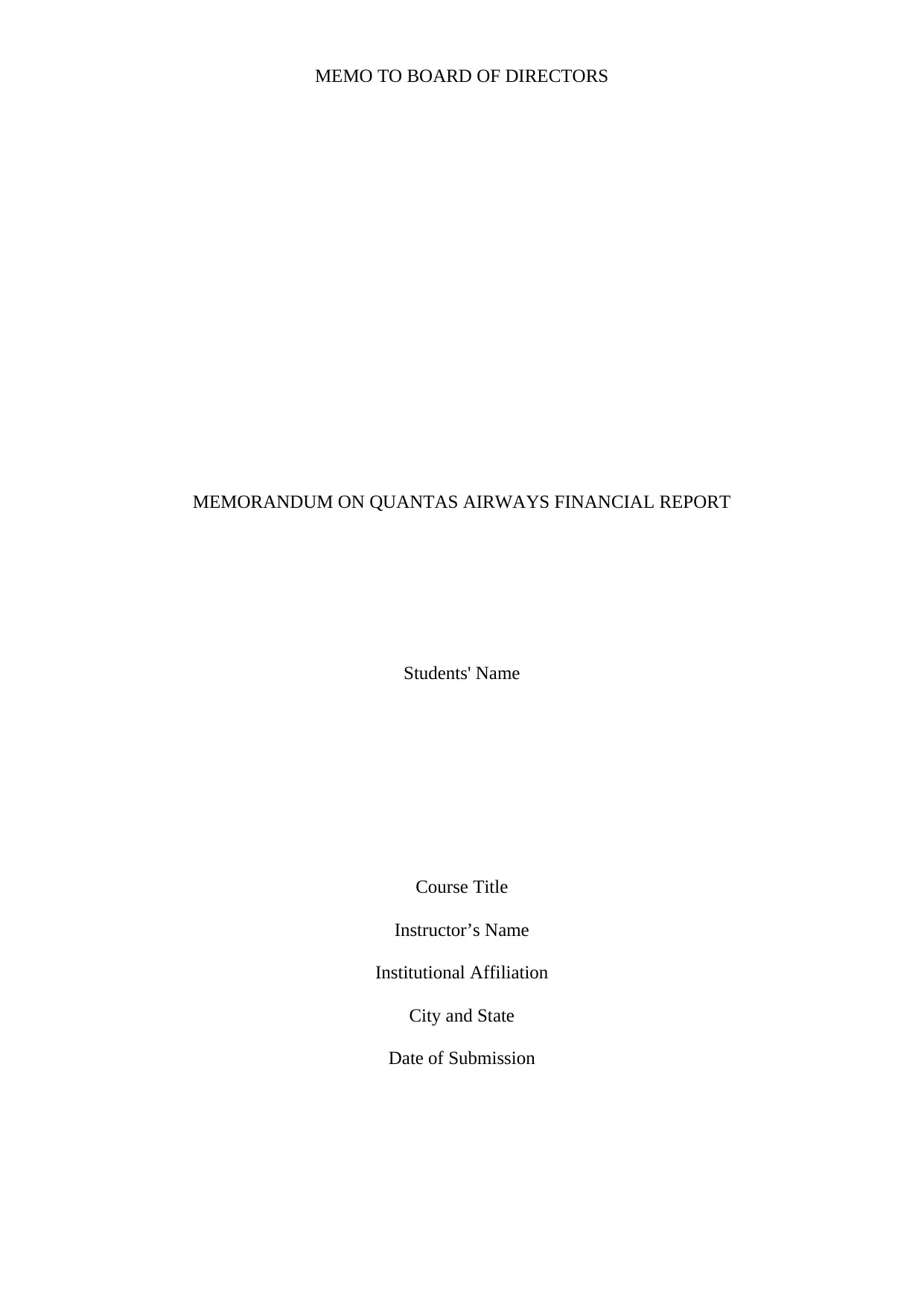
MEMO TO BOARD OF DIRECTORS
MEMORANDUM ON QUANTAS AIRWAYS FINANCIAL REPORT
Students' Name
Course Title
Instructor’s Name
Institutional Affiliation
City and State
Date of Submission
MEMORANDUM ON QUANTAS AIRWAYS FINANCIAL REPORT
Students' Name
Course Title
Instructor’s Name
Institutional Affiliation
City and State
Date of Submission
Paraphrase This Document
Need a fresh take? Get an instant paraphrase of this document with our AI Paraphraser
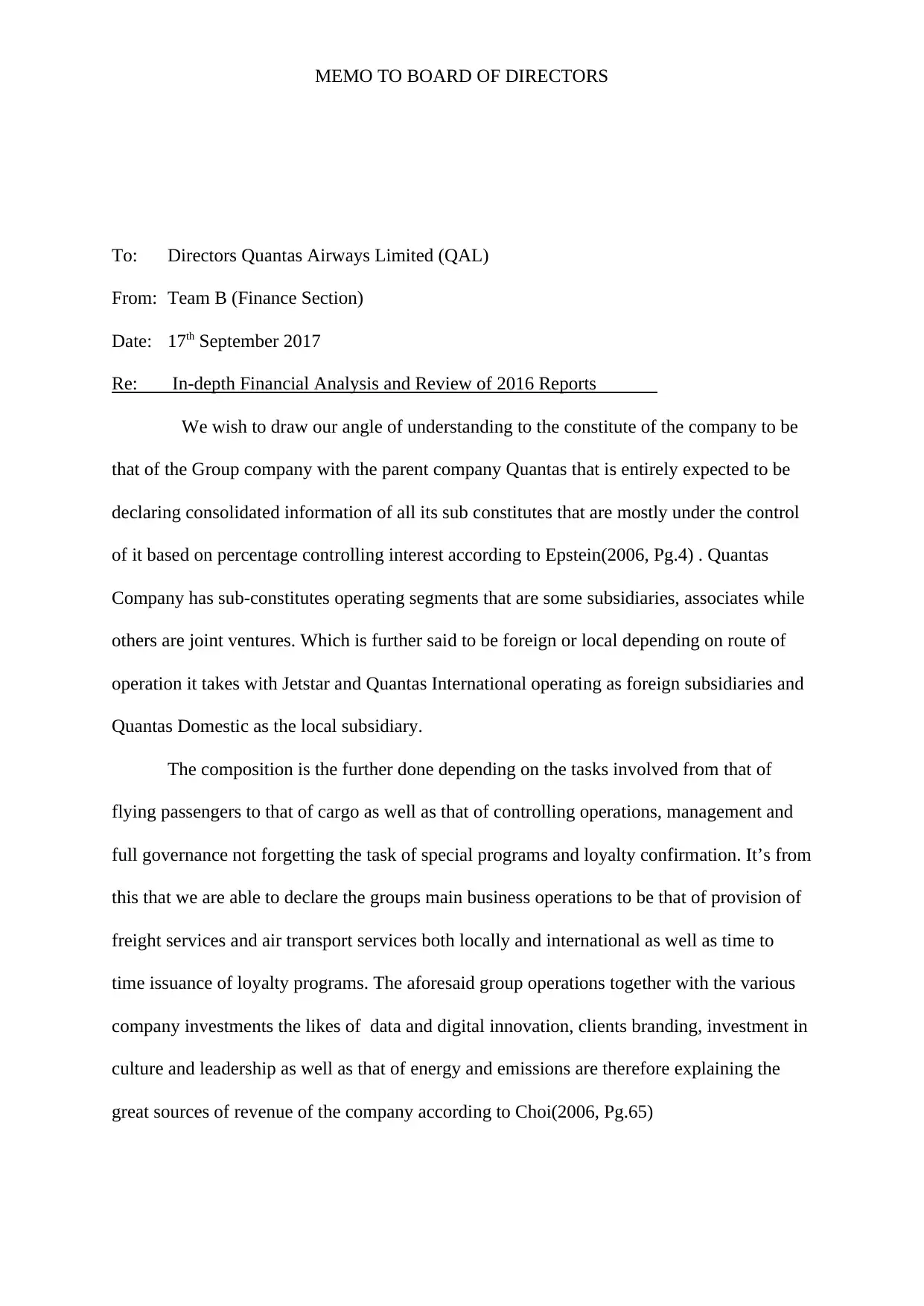
MEMO TO BOARD OF DIRECTORS
To: Directors Quantas Airways Limited (QAL)
From: Team B (Finance Section)
Date: 17th September 2017
Re: In-depth Financial Analysis and Review of 2016 Reports
We wish to draw our angle of understanding to the constitute of the company to be
that of the Group company with the parent company Quantas that is entirely expected to be
declaring consolidated information of all its sub constitutes that are mostly under the control
of it based on percentage controlling interest according to Epstein(2006, Pg.4) . Quantas
Company has sub-constitutes operating segments that are some subsidiaries, associates while
others are joint ventures. Which is further said to be foreign or local depending on route of
operation it takes with Jetstar and Quantas International operating as foreign subsidiaries and
Quantas Domestic as the local subsidiary.
The composition is the further done depending on the tasks involved from that of
flying passengers to that of cargo as well as that of controlling operations, management and
full governance not forgetting the task of special programs and loyalty confirmation. It’s from
this that we are able to declare the groups main business operations to be that of provision of
freight services and air transport services both locally and international as well as time to
time issuance of loyalty programs. The aforesaid group operations together with the various
company investments the likes of data and digital innovation, clients branding, investment in
culture and leadership as well as that of energy and emissions are therefore explaining the
great sources of revenue of the company according to Choi(2006, Pg.65)
To: Directors Quantas Airways Limited (QAL)
From: Team B (Finance Section)
Date: 17th September 2017
Re: In-depth Financial Analysis and Review of 2016 Reports
We wish to draw our angle of understanding to the constitute of the company to be
that of the Group company with the parent company Quantas that is entirely expected to be
declaring consolidated information of all its sub constitutes that are mostly under the control
of it based on percentage controlling interest according to Epstein(2006, Pg.4) . Quantas
Company has sub-constitutes operating segments that are some subsidiaries, associates while
others are joint ventures. Which is further said to be foreign or local depending on route of
operation it takes with Jetstar and Quantas International operating as foreign subsidiaries and
Quantas Domestic as the local subsidiary.
The composition is the further done depending on the tasks involved from that of
flying passengers to that of cargo as well as that of controlling operations, management and
full governance not forgetting the task of special programs and loyalty confirmation. It’s from
this that we are able to declare the groups main business operations to be that of provision of
freight services and air transport services both locally and international as well as time to
time issuance of loyalty programs. The aforesaid group operations together with the various
company investments the likes of data and digital innovation, clients branding, investment in
culture and leadership as well as that of energy and emissions are therefore explaining the
great sources of revenue of the company according to Choi(2006, Pg.65)
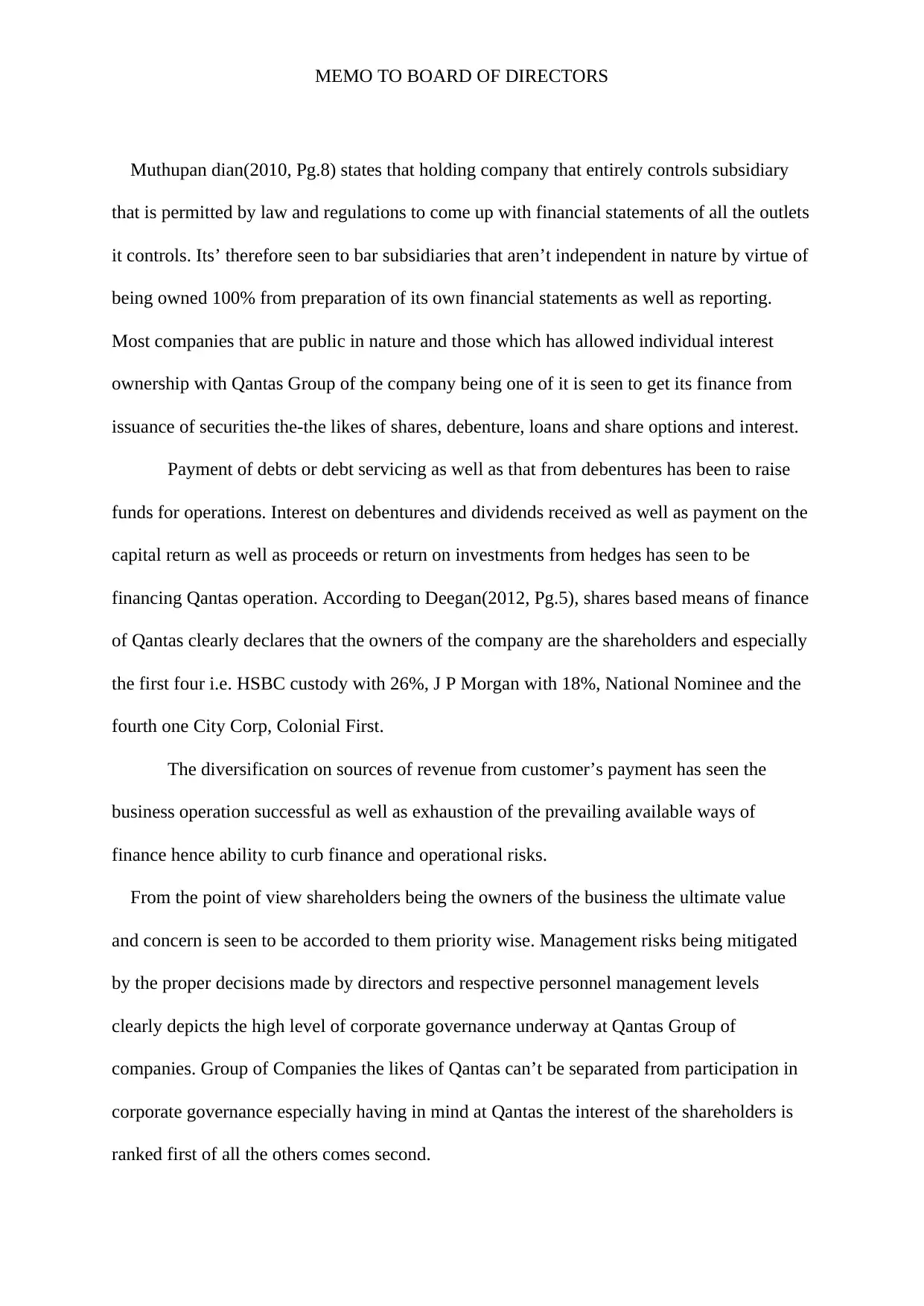
MEMO TO BOARD OF DIRECTORS
Muthupan dian(2010, Pg.8) states that holding company that entirely controls subsidiary
that is permitted by law and regulations to come up with financial statements of all the outlets
it controls. Its’ therefore seen to bar subsidiaries that aren’t independent in nature by virtue of
being owned 100% from preparation of its own financial statements as well as reporting.
Most companies that are public in nature and those which has allowed individual interest
ownership with Qantas Group of the company being one of it is seen to get its finance from
issuance of securities the-the likes of shares, debenture, loans and share options and interest.
Payment of debts or debt servicing as well as that from debentures has been to raise
funds for operations. Interest on debentures and dividends received as well as payment on the
capital return as well as proceeds or return on investments from hedges has seen to be
financing Qantas operation. According to Deegan(2012, Pg.5), shares based means of finance
of Qantas clearly declares that the owners of the company are the shareholders and especially
the first four i.e. HSBC custody with 26%, J P Morgan with 18%, National Nominee and the
fourth one City Corp, Colonial First.
The diversification on sources of revenue from customer’s payment has seen the
business operation successful as well as exhaustion of the prevailing available ways of
finance hence ability to curb finance and operational risks.
From the point of view shareholders being the owners of the business the ultimate value
and concern is seen to be accorded to them priority wise. Management risks being mitigated
by the proper decisions made by directors and respective personnel management levels
clearly depicts the high level of corporate governance underway at Qantas Group of
companies. Group of Companies the likes of Qantas can’t be separated from participation in
corporate governance especially having in mind at Qantas the interest of the shareholders is
ranked first of all the others comes second.
Muthupan dian(2010, Pg.8) states that holding company that entirely controls subsidiary
that is permitted by law and regulations to come up with financial statements of all the outlets
it controls. Its’ therefore seen to bar subsidiaries that aren’t independent in nature by virtue of
being owned 100% from preparation of its own financial statements as well as reporting.
Most companies that are public in nature and those which has allowed individual interest
ownership with Qantas Group of the company being one of it is seen to get its finance from
issuance of securities the-the likes of shares, debenture, loans and share options and interest.
Payment of debts or debt servicing as well as that from debentures has been to raise
funds for operations. Interest on debentures and dividends received as well as payment on the
capital return as well as proceeds or return on investments from hedges has seen to be
financing Qantas operation. According to Deegan(2012, Pg.5), shares based means of finance
of Qantas clearly declares that the owners of the company are the shareholders and especially
the first four i.e. HSBC custody with 26%, J P Morgan with 18%, National Nominee and the
fourth one City Corp, Colonial First.
The diversification on sources of revenue from customer’s payment has seen the
business operation successful as well as exhaustion of the prevailing available ways of
finance hence ability to curb finance and operational risks.
From the point of view shareholders being the owners of the business the ultimate value
and concern is seen to be accorded to them priority wise. Management risks being mitigated
by the proper decisions made by directors and respective personnel management levels
clearly depicts the high level of corporate governance underway at Qantas Group of
companies. Group of Companies the likes of Qantas can’t be separated from participation in
corporate governance especially having in mind at Qantas the interest of the shareholders is
ranked first of all the others comes second.
⊘ This is a preview!⊘
Do you want full access?
Subscribe today to unlock all pages.

Trusted by 1+ million students worldwide
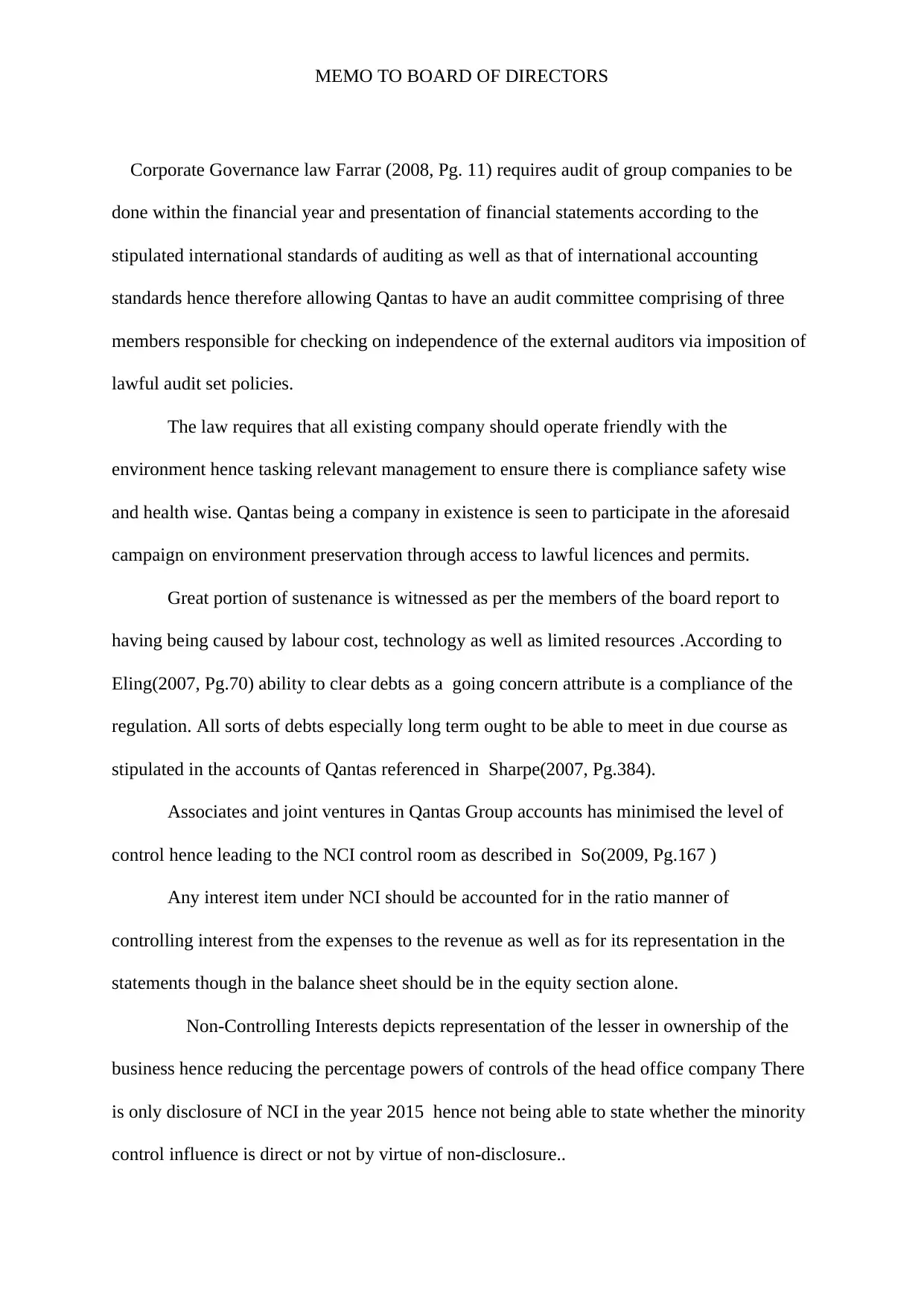
MEMO TO BOARD OF DIRECTORS
Corporate Governance law Farrar (2008, Pg. 11) requires audit of group companies to be
done within the financial year and presentation of financial statements according to the
stipulated international standards of auditing as well as that of international accounting
standards hence therefore allowing Qantas to have an audit committee comprising of three
members responsible for checking on independence of the external auditors via imposition of
lawful audit set policies.
The law requires that all existing company should operate friendly with the
environment hence tasking relevant management to ensure there is compliance safety wise
and health wise. Qantas being a company in existence is seen to participate in the aforesaid
campaign on environment preservation through access to lawful licences and permits.
Great portion of sustenance is witnessed as per the members of the board report to
having being caused by labour cost, technology as well as limited resources .According to
Eling(2007, Pg.70) ability to clear debts as a going concern attribute is a compliance of the
regulation. All sorts of debts especially long term ought to be able to meet in due course as
stipulated in the accounts of Qantas referenced in Sharpe(2007, Pg.384).
Associates and joint ventures in Qantas Group accounts has minimised the level of
control hence leading to the NCI control room as described in So(2009, Pg.167 )
Any interest item under NCI should be accounted for in the ratio manner of
controlling interest from the expenses to the revenue as well as for its representation in the
statements though in the balance sheet should be in the equity section alone.
Non-Controlling Interests depicts representation of the lesser in ownership of the
business hence reducing the percentage powers of controls of the head office company There
is only disclosure of NCI in the year 2015 hence not being able to state whether the minority
control influence is direct or not by virtue of non-disclosure..
Corporate Governance law Farrar (2008, Pg. 11) requires audit of group companies to be
done within the financial year and presentation of financial statements according to the
stipulated international standards of auditing as well as that of international accounting
standards hence therefore allowing Qantas to have an audit committee comprising of three
members responsible for checking on independence of the external auditors via imposition of
lawful audit set policies.
The law requires that all existing company should operate friendly with the
environment hence tasking relevant management to ensure there is compliance safety wise
and health wise. Qantas being a company in existence is seen to participate in the aforesaid
campaign on environment preservation through access to lawful licences and permits.
Great portion of sustenance is witnessed as per the members of the board report to
having being caused by labour cost, technology as well as limited resources .According to
Eling(2007, Pg.70) ability to clear debts as a going concern attribute is a compliance of the
regulation. All sorts of debts especially long term ought to be able to meet in due course as
stipulated in the accounts of Qantas referenced in Sharpe(2007, Pg.384).
Associates and joint ventures in Qantas Group accounts has minimised the level of
control hence leading to the NCI control room as described in So(2009, Pg.167 )
Any interest item under NCI should be accounted for in the ratio manner of
controlling interest from the expenses to the revenue as well as for its representation in the
statements though in the balance sheet should be in the equity section alone.
Non-Controlling Interests depicts representation of the lesser in ownership of the
business hence reducing the percentage powers of controls of the head office company There
is only disclosure of NCI in the year 2015 hence not being able to state whether the minority
control influence is direct or not by virtue of non-disclosure..
Paraphrase This Document
Need a fresh take? Get an instant paraphrase of this document with our AI Paraphraser
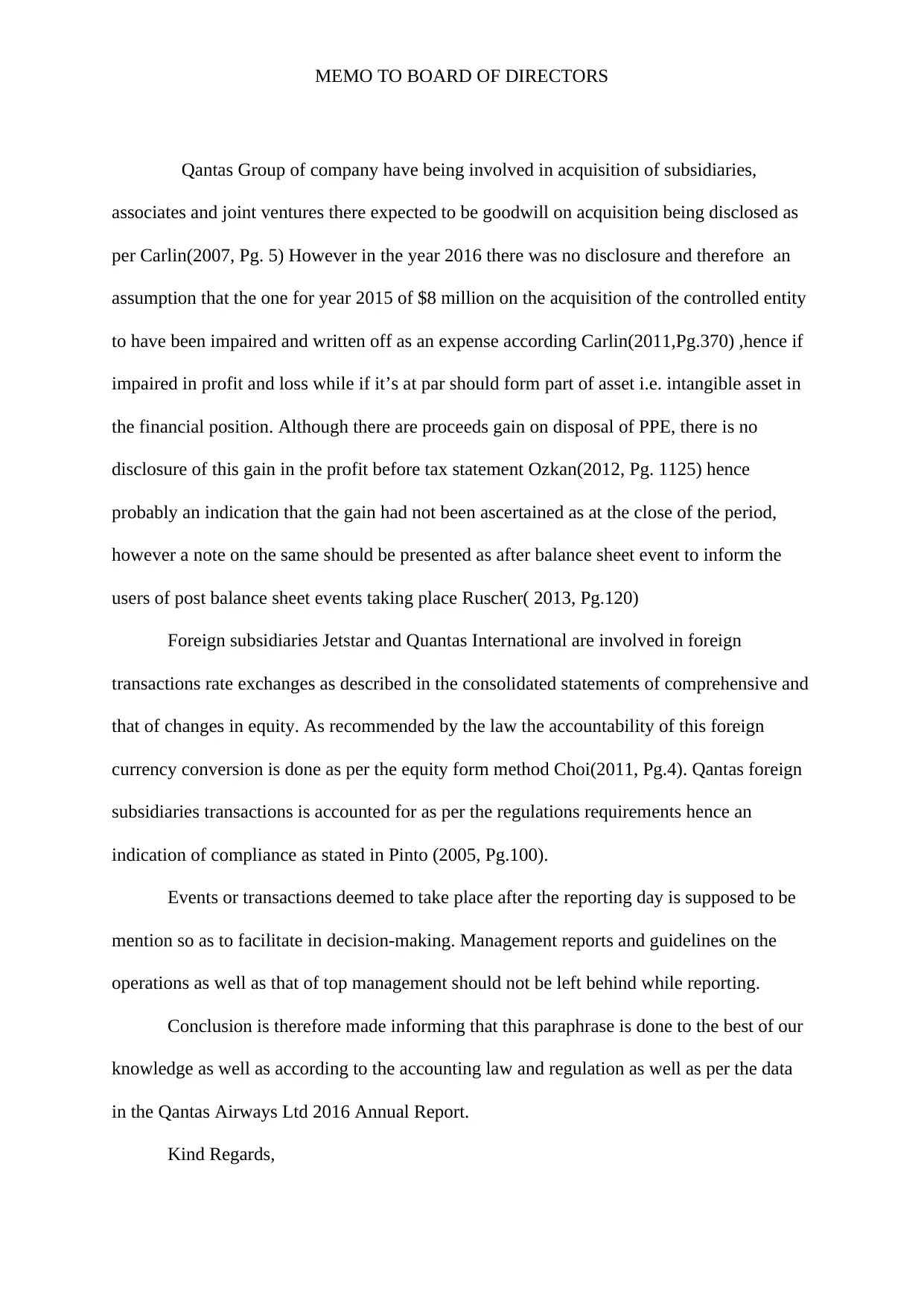
MEMO TO BOARD OF DIRECTORS
Qantas Group of company have being involved in acquisition of subsidiaries,
associates and joint ventures there expected to be goodwill on acquisition being disclosed as
per Carlin(2007, Pg. 5) However in the year 2016 there was no disclosure and therefore an
assumption that the one for year 2015 of $8 million on the acquisition of the controlled entity
to have been impaired and written off as an expense according Carlin(2011,Pg.370) ,hence if
impaired in profit and loss while if it’s at par should form part of asset i.e. intangible asset in
the financial position. Although there are proceeds gain on disposal of PPE, there is no
disclosure of this gain in the profit before tax statement Ozkan(2012, Pg. 1125) hence
probably an indication that the gain had not been ascertained as at the close of the period,
however a note on the same should be presented as after balance sheet event to inform the
users of post balance sheet events taking place Ruscher( 2013, Pg.120)
Foreign subsidiaries Jetstar and Quantas International are involved in foreign
transactions rate exchanges as described in the consolidated statements of comprehensive and
that of changes in equity. As recommended by the law the accountability of this foreign
currency conversion is done as per the equity form method Choi(2011, Pg.4). Qantas foreign
subsidiaries transactions is accounted for as per the regulations requirements hence an
indication of compliance as stated in Pinto (2005, Pg.100).
Events or transactions deemed to take place after the reporting day is supposed to be
mention so as to facilitate in decision-making. Management reports and guidelines on the
operations as well as that of top management should not be left behind while reporting.
Conclusion is therefore made informing that this paraphrase is done to the best of our
knowledge as well as according to the accounting law and regulation as well as per the data
in the Qantas Airways Ltd 2016 Annual Report.
Kind Regards,
Qantas Group of company have being involved in acquisition of subsidiaries,
associates and joint ventures there expected to be goodwill on acquisition being disclosed as
per Carlin(2007, Pg. 5) However in the year 2016 there was no disclosure and therefore an
assumption that the one for year 2015 of $8 million on the acquisition of the controlled entity
to have been impaired and written off as an expense according Carlin(2011,Pg.370) ,hence if
impaired in profit and loss while if it’s at par should form part of asset i.e. intangible asset in
the financial position. Although there are proceeds gain on disposal of PPE, there is no
disclosure of this gain in the profit before tax statement Ozkan(2012, Pg. 1125) hence
probably an indication that the gain had not been ascertained as at the close of the period,
however a note on the same should be presented as after balance sheet event to inform the
users of post balance sheet events taking place Ruscher( 2013, Pg.120)
Foreign subsidiaries Jetstar and Quantas International are involved in foreign
transactions rate exchanges as described in the consolidated statements of comprehensive and
that of changes in equity. As recommended by the law the accountability of this foreign
currency conversion is done as per the equity form method Choi(2011, Pg.4). Qantas foreign
subsidiaries transactions is accounted for as per the regulations requirements hence an
indication of compliance as stated in Pinto (2005, Pg.100).
Events or transactions deemed to take place after the reporting day is supposed to be
mention so as to facilitate in decision-making. Management reports and guidelines on the
operations as well as that of top management should not be left behind while reporting.
Conclusion is therefore made informing that this paraphrase is done to the best of our
knowledge as well as according to the accounting law and regulation as well as per the data
in the Qantas Airways Ltd 2016 Annual Report.
Kind Regards,
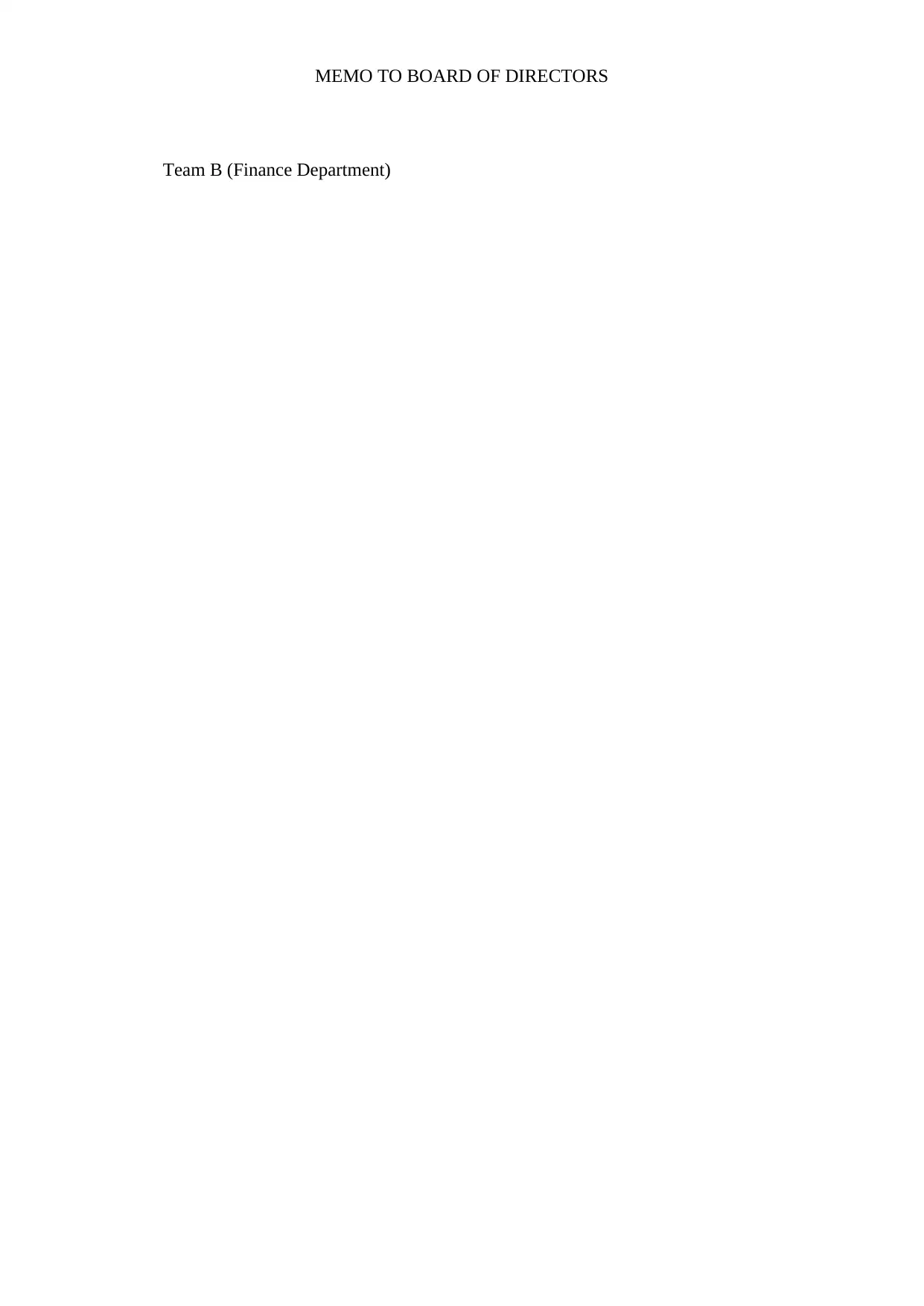
MEMO TO BOARD OF DIRECTORS
Team B (Finance Department)
Team B (Finance Department)
⊘ This is a preview!⊘
Do you want full access?
Subscribe today to unlock all pages.

Trusted by 1+ million students worldwide
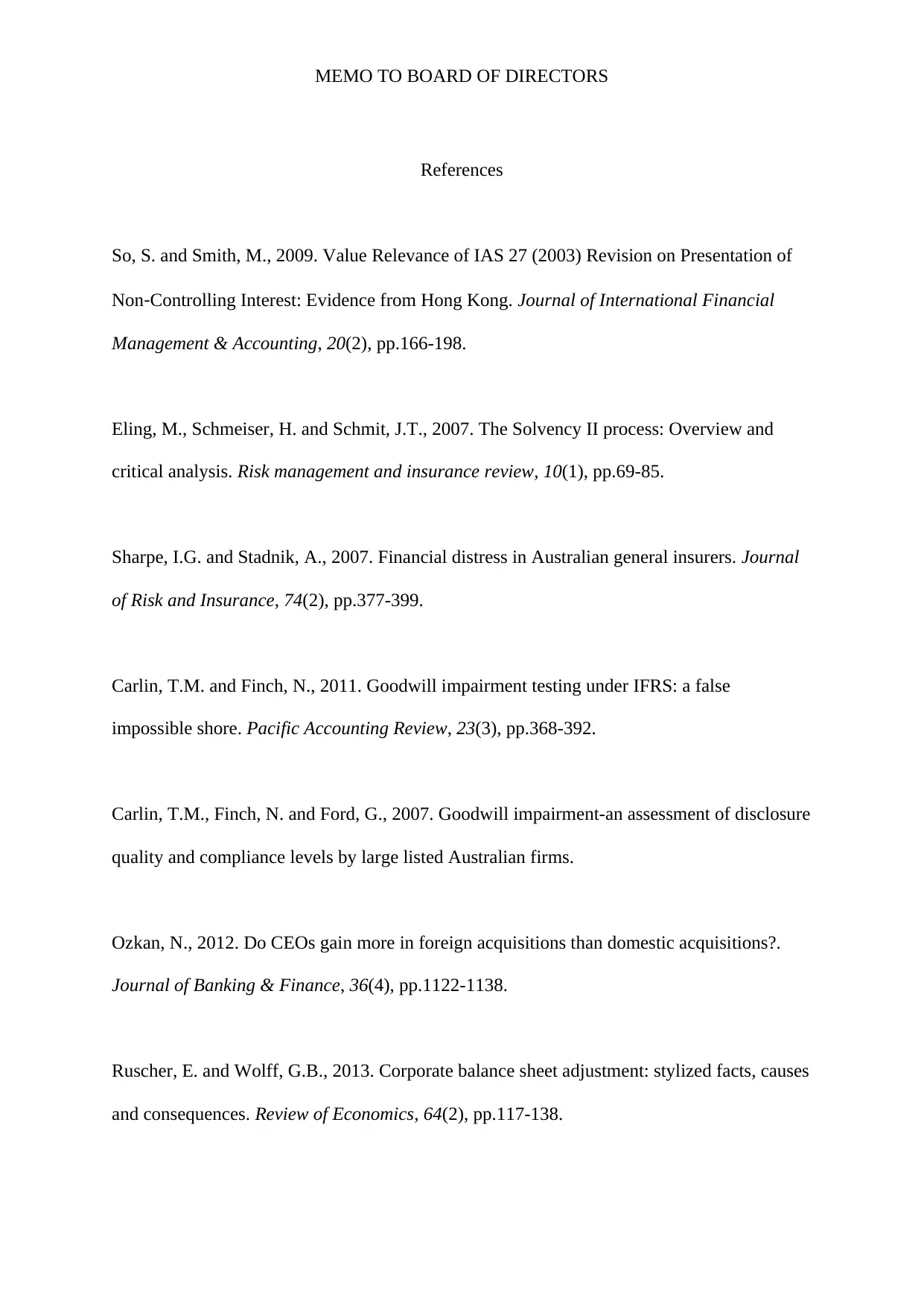
MEMO TO BOARD OF DIRECTORS
References
So, S. and Smith, M., 2009. Value Relevance of IAS 27 (2003) Revision on Presentation of
Non‐Controlling Interest: Evidence from Hong Kong. Journal of International Financial
Management & Accounting, 20(2), pp.166-198.
Eling, M., Schmeiser, H. and Schmit, J.T., 2007. The Solvency II process: Overview and
critical analysis. Risk management and insurance review, 10(1), pp.69-85.
Sharpe, I.G. and Stadnik, A., 2007. Financial distress in Australian general insurers. Journal
of Risk and Insurance, 74(2), pp.377-399.
Carlin, T.M. and Finch, N., 2011. Goodwill impairment testing under IFRS: a false
impossible shore. Pacific Accounting Review, 23(3), pp.368-392.
Carlin, T.M., Finch, N. and Ford, G., 2007. Goodwill impairment-an assessment of disclosure
quality and compliance levels by large listed Australian firms.
Ozkan, N., 2012. Do CEOs gain more in foreign acquisitions than domestic acquisitions?.
Journal of Banking & Finance, 36(4), pp.1122-1138.
Ruscher, E. and Wolff, G.B., 2013. Corporate balance sheet adjustment: stylized facts, causes
and consequences. Review of Economics, 64(2), pp.117-138.
References
So, S. and Smith, M., 2009. Value Relevance of IAS 27 (2003) Revision on Presentation of
Non‐Controlling Interest: Evidence from Hong Kong. Journal of International Financial
Management & Accounting, 20(2), pp.166-198.
Eling, M., Schmeiser, H. and Schmit, J.T., 2007. The Solvency II process: Overview and
critical analysis. Risk management and insurance review, 10(1), pp.69-85.
Sharpe, I.G. and Stadnik, A., 2007. Financial distress in Australian general insurers. Journal
of Risk and Insurance, 74(2), pp.377-399.
Carlin, T.M. and Finch, N., 2011. Goodwill impairment testing under IFRS: a false
impossible shore. Pacific Accounting Review, 23(3), pp.368-392.
Carlin, T.M., Finch, N. and Ford, G., 2007. Goodwill impairment-an assessment of disclosure
quality and compliance levels by large listed Australian firms.
Ozkan, N., 2012. Do CEOs gain more in foreign acquisitions than domestic acquisitions?.
Journal of Banking & Finance, 36(4), pp.1122-1138.
Ruscher, E. and Wolff, G.B., 2013. Corporate balance sheet adjustment: stylized facts, causes
and consequences. Review of Economics, 64(2), pp.117-138.
Paraphrase This Document
Need a fresh take? Get an instant paraphrase of this document with our AI Paraphraser
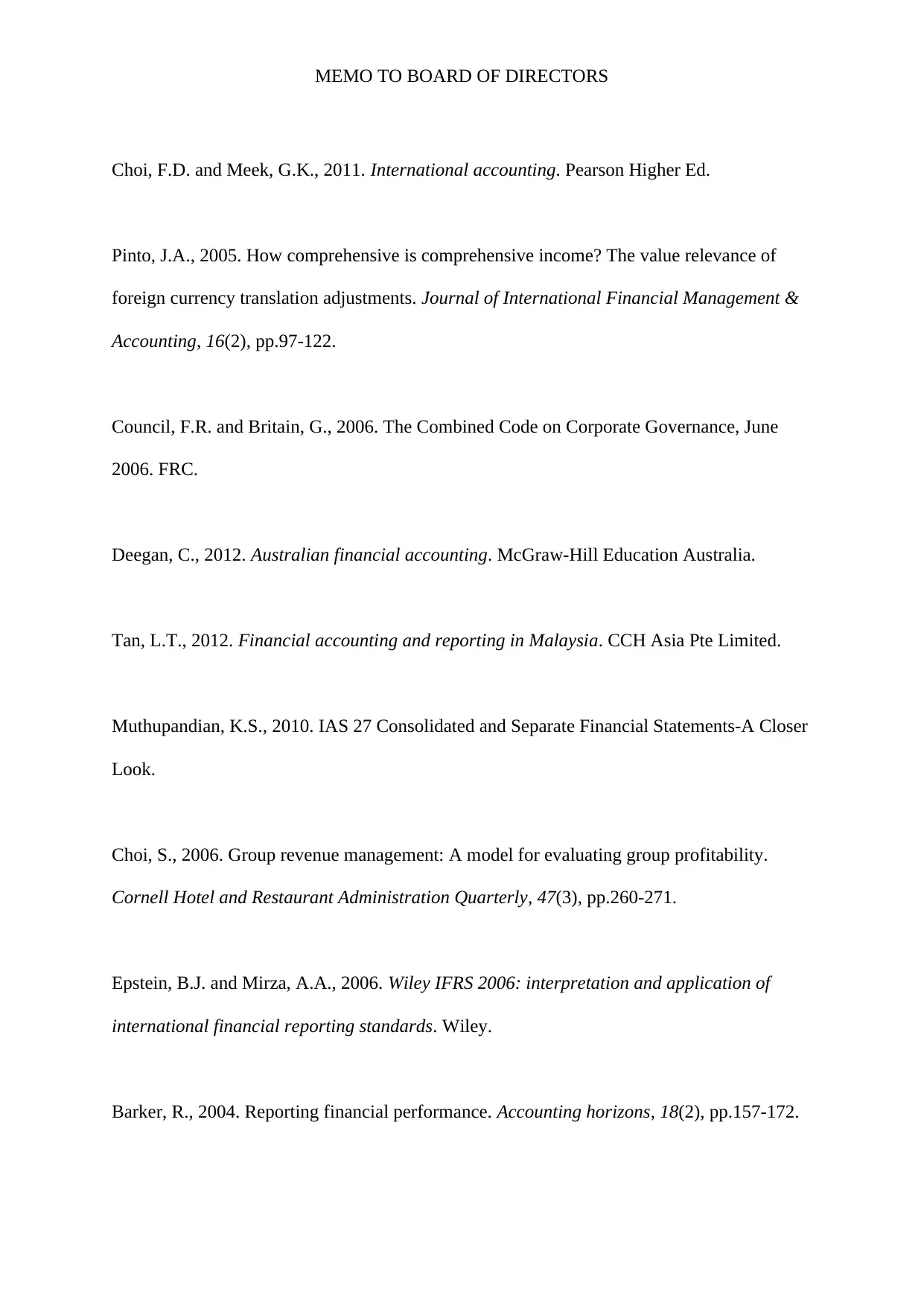
MEMO TO BOARD OF DIRECTORS
Choi, F.D. and Meek, G.K., 2011. International accounting. Pearson Higher Ed.
Pinto, J.A., 2005. How comprehensive is comprehensive income? The value relevance of
foreign currency translation adjustments. Journal of International Financial Management &
Accounting, 16(2), pp.97-122.
Council, F.R. and Britain, G., 2006. The Combined Code on Corporate Governance, June
2006. FRC.
Deegan, C., 2012. Australian financial accounting. McGraw-Hill Education Australia.
Tan, L.T., 2012. Financial accounting and reporting in Malaysia. CCH Asia Pte Limited.
Muthupandian, K.S., 2010. IAS 27 Consolidated and Separate Financial Statements-A Closer
Look.
Choi, S., 2006. Group revenue management: A model for evaluating group profitability.
Cornell Hotel and Restaurant Administration Quarterly, 47(3), pp.260-271.
Epstein, B.J. and Mirza, A.A., 2006. Wiley IFRS 2006: interpretation and application of
international financial reporting standards. Wiley.
Barker, R., 2004. Reporting financial performance. Accounting horizons, 18(2), pp.157-172.
Choi, F.D. and Meek, G.K., 2011. International accounting. Pearson Higher Ed.
Pinto, J.A., 2005. How comprehensive is comprehensive income? The value relevance of
foreign currency translation adjustments. Journal of International Financial Management &
Accounting, 16(2), pp.97-122.
Council, F.R. and Britain, G., 2006. The Combined Code on Corporate Governance, June
2006. FRC.
Deegan, C., 2012. Australian financial accounting. McGraw-Hill Education Australia.
Tan, L.T., 2012. Financial accounting and reporting in Malaysia. CCH Asia Pte Limited.
Muthupandian, K.S., 2010. IAS 27 Consolidated and Separate Financial Statements-A Closer
Look.
Choi, S., 2006. Group revenue management: A model for evaluating group profitability.
Cornell Hotel and Restaurant Administration Quarterly, 47(3), pp.260-271.
Epstein, B.J. and Mirza, A.A., 2006. Wiley IFRS 2006: interpretation and application of
international financial reporting standards. Wiley.
Barker, R., 2004. Reporting financial performance. Accounting horizons, 18(2), pp.157-172.
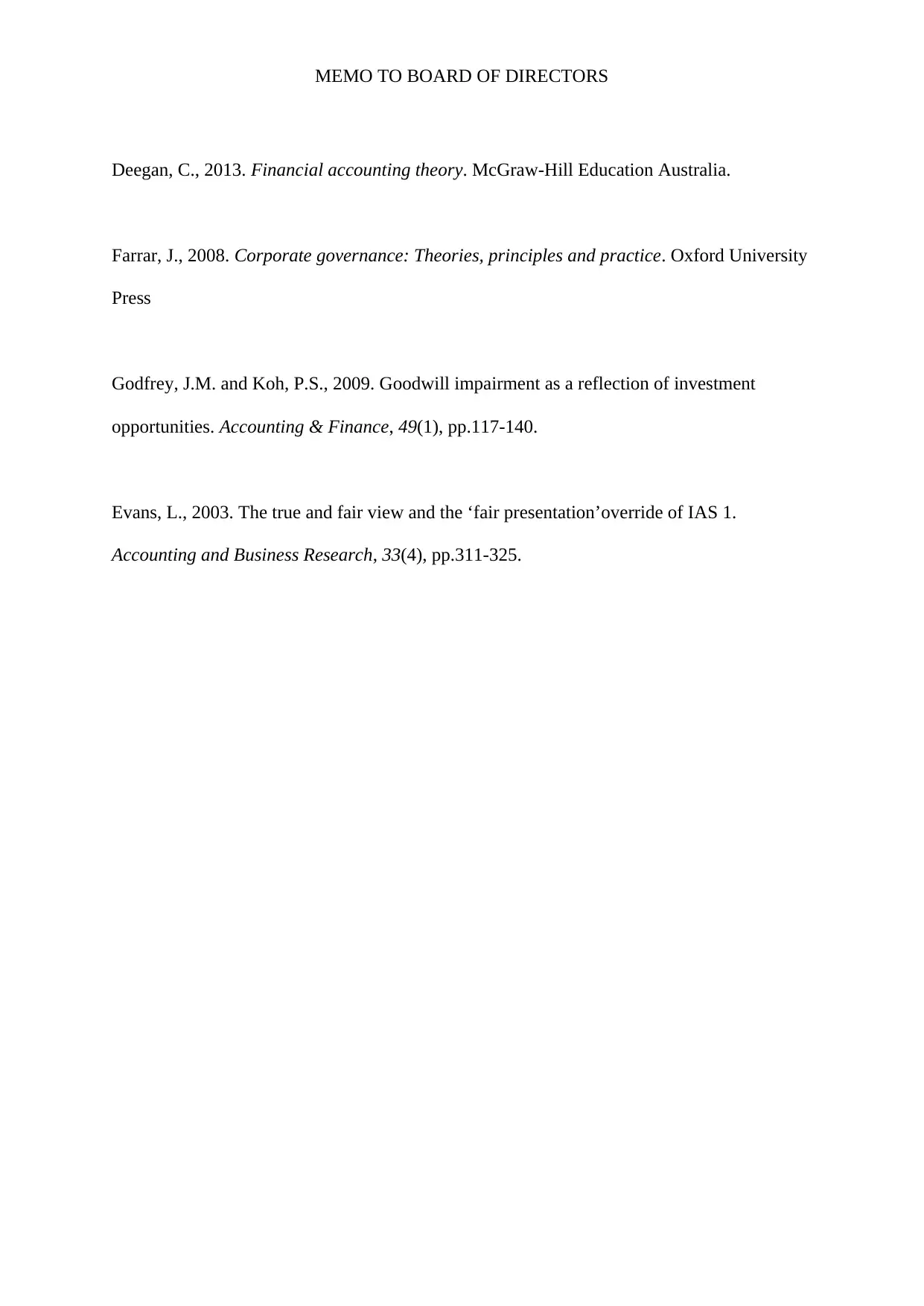
MEMO TO BOARD OF DIRECTORS
Deegan, C., 2013. Financial accounting theory. McGraw-Hill Education Australia.
Farrar, J., 2008. Corporate governance: Theories, principles and practice. Oxford University
Press
Godfrey, J.M. and Koh, P.S., 2009. Goodwill impairment as a reflection of investment
opportunities. Accounting & Finance, 49(1), pp.117-140.
Evans, L., 2003. The true and fair view and the ‘fair presentation’override of IAS 1.
Accounting and Business Research, 33(4), pp.311-325.
Deegan, C., 2013. Financial accounting theory. McGraw-Hill Education Australia.
Farrar, J., 2008. Corporate governance: Theories, principles and practice. Oxford University
Press
Godfrey, J.M. and Koh, P.S., 2009. Goodwill impairment as a reflection of investment
opportunities. Accounting & Finance, 49(1), pp.117-140.
Evans, L., 2003. The true and fair view and the ‘fair presentation’override of IAS 1.
Accounting and Business Research, 33(4), pp.311-325.
⊘ This is a preview!⊘
Do you want full access?
Subscribe today to unlock all pages.

Trusted by 1+ million students worldwide
1 out of 9
Related Documents
Your All-in-One AI-Powered Toolkit for Academic Success.
+13062052269
info@desklib.com
Available 24*7 on WhatsApp / Email
![[object Object]](/_next/static/media/star-bottom.7253800d.svg)
Unlock your academic potential
Copyright © 2020–2025 A2Z Services. All Rights Reserved. Developed and managed by ZUCOL.





